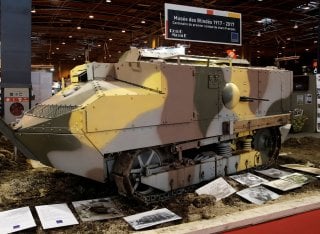The First French Tank: Meet the Schneider CA1
Hundreds of these tanks were built and saw service on the Western Front.
The brutal trench warfare of World War One necessitated the development of the tank, which was intended to safely traverse No Man’s Land and the myriad obstacles like barbed wire and craters that dotted the ground between front lines. Perhaps the most recognizable tank of the war were the British heavy tanks—the Schneider CA1 was France’s version of the tank.
The Schneider was originally intended as an infantry support vehicle rather than as standalone tank. The Schneider’s main purpose was to create channels through No Man’s Land through which thousands of infantry troops would pour, towards German lines and into their trenches.
Landship
To achieve this purpose, the Schneider had a peculiar boat-like prow. This pointed front served two purposes. The fist was to push down and aside barbed wire obstacles that littered the battlefield so that the wire would be out of the way for dismounted infantry. It was also hoped that the prow shape would assist the Schneider in getting across trenches, as the front end tended to make contact with trench walls and get stuck.
The strange tank’s armament was irregularly placed. A single 75 millimeter cannon was on the Schneider’s right forward corner and had only a limited traverse. Its location inside the tank necessitated a very compact design, which resulted in a very short barrel. The short barrel length had an adverse effect on both projectile velocity, and accuracy.
By period artillery standards, the Schneider had to be virtually on top of German lines before it could score chance hits at maximum range, a little over 2,000 meters or a bit above one mile. Aiming was coordinated by both the gunner and the driver, as the Schneider had to face enemy trenches at an oblique angle for the gun to face the right direction. In addition to the single 75 millimeter gun, two machine guns were mounted internally on pintles.
Amazingly, a crew of six were expected to fit inside the Schneider: two machine gunners, a driver/commander, a 75 mm cannon gunner, a loader for the cannon, and one mechanic/machine gun loader. Ventilation in the terribly cramped space was achieved through ventilation slits in the roof, which were intended to suck hot air and shooting fumes outside the vehicle.
Flawed Design
Though significantly more capable than preceding tank designs, the Schneider CA1 had a several design flaws that hindered usefulness. Externally carried fuel tanks were prone to catching fire when hit. Moreover, in order to increase range, additional fuel was sometime carried inside and was very likely to explode if enemy artillery penetrated the Schneider’s armor.
Additional rounds for the 75 millimeter gun were sometimes carried externally—a seriously dangerous practice. Compounding the problem, bottles of spirits—also flammable—were carried inside, so-called “liquid courage” to increase crew bravery.
Postscript
Ultimately the Schneider CA1 was not all that its designers had intended, though it was a significant improvement compared to previous French designs that were incredibly slow and ungainly. Other designs proved to be more capable, but wouldn’t have been possible without the lessons learned from the Schneider design.
Caleb Larson holds a Master of Public Policy degree from the Willy Brandt School of Public Policy. He lives in Berlin and writes on U.S. and Russian foreign and defense policy, German politics, and culture.
Image: Reuters

